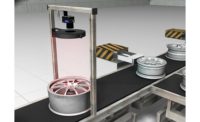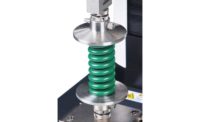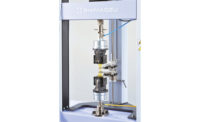The term “backlight” has two common meanings. One is a lighting product which is a planar uniform light source; the other is as a silhouetting lighting solution that may use that type of light source.
In Figure 1, we can see an example of a typical backlight product. This light source is typically made using LEDs within a rectangular shape behind a diffusing cover. This particular product is red, a common choice.
Figure 2 shows a backlight product and backlighting solution being used for automatic thread inspection. Here, it has been used to do high-accuracy gaging on a product (based on the now clearly-defined borders). Backlights can also be used to find holes and gaps in a product (the light will shine through, creating differentiation). The light creates contrast between the dark figure of the object in front and the well-lit background behind it.
Creating a backlighting solution for high accuracy gaging isn’t as easy as it seems. This requires recognizing and reducing numerous sources of error such as edges that are fuzzy (at a microscopic scale), or light that “wraps around” the product, altering the image of the “true edge.” Some techniques for rectifying this include: masking the light source for more optimal edge definition; adjusting the distances between the camera, work piece and light source; choosing a monochromatic light source; making provisions and compensating in software; or by using a collinear light source instead of a backlight product.
However, backlighting isn’t the only use for backlights. In our machine vision lighting design courses, we remind customers it is useful to think of a standard “backlight” as a planar light source instead. In this way, backlight products can be used for more than just backlighting solutions and backlighting solutions can be designed with lights other than standard backlights.
One powerful but lesser-known use of a backlight product (as shown in Figure 3) is to use it to create a specular lighting solution (glare) to differentiate mechanical defects (such as dents or scratches). These types of defects do not change the color or darkness of the surface. Here, we would position the product, camera and light source to produce a “sweet spot” (where the lighting solution is valid). This area is roughly a reflection on the work piece of the emissive area of the light source. In fact, for flat surfaces, it can be designed and tested by substituting a mirror for the work piece surface and viewing it through the camera. The area on the mirror in the image occupied by the emissive part of the light source is the area where the specular light solution is valid.
A special but common case for a specular lighting solution is when the camera axis is perpendicular to the product and the required feature differentiation demands a specular solution for a ring shaped area. One example is to inspect a ring shaped surface on a product for defects and dimensions. Figure 3 shows a method to determine which areas must be emissive.
Because we are often contacted for engineering advice on difficult applications, our lighting solutions sometimes call for shapes of backlights which are not commercially available. In these cases we have manufactured custom-shaped backlights. Figure 4 shows one built for an application which required an annular shaped emissive area. The term “annular” emphasizes that that the entire two-inch width must be evenly emissive, unlike a typical ring light. The resultant shapes often fill availability gaps and become popular products.
Fred Turek is Chief Operating Officer and Kim Jackson is Project Coordinator, both are from FSI Technologies Inc. (Lombard, IL).
For more information, call (800) 468-6009, email [email protected] or visit www.fsinet.com.





